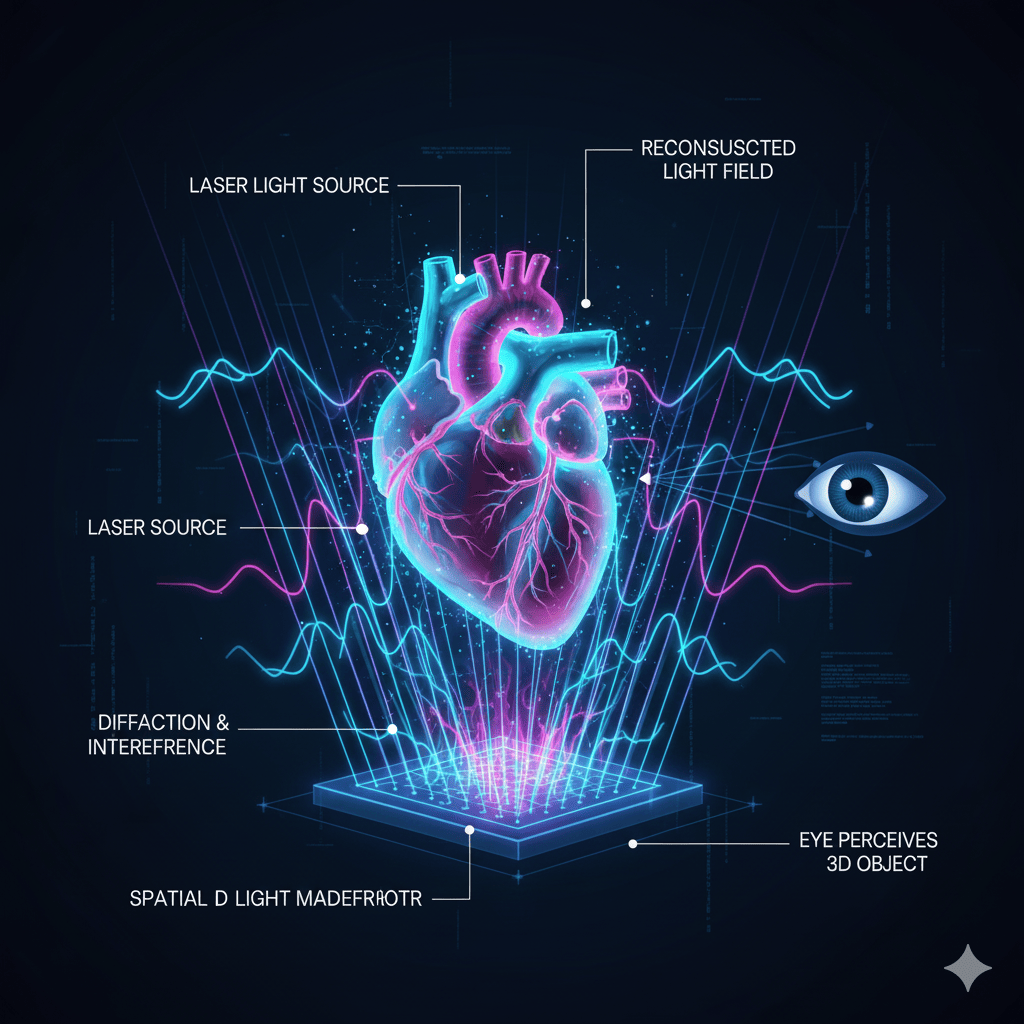For decades, the notion of a floating 3D hologram — without glasses or headsets — has been a staple of science fiction. But modern optics, computational photography, and display engineering are bringing holographic displays closer to everyday reality. These systems create volumetric, light-field, or directional images that appear three-dimensional to viewers. And recent advances are making them sharper, interactive, and scalable.

How Holographic Displays Work
A holographic display uses principles of light diffraction, interference, and phase control to project a 3D image. Unlike traditional 2D displays, they reconstruct wavefronts so our eyes perceive depth.
Key approaches include:
- Diffraction-based holography / phase holograms: Using spatial light modulators to modulate the phase of light and produce interference patterns.
- Directional pixel & light field displays: Techniques like ECHO use directional pixels so that different viewing angles see appropriate perspectives.
- Volumetric displays / scanning volumes: Projecting images on different depth planes by scanning or layering media.
- Interactive holograms / touchable holograms: Some experimental systems use elastic media or force feedback so users can “touch” or manipulate holograms.
For example, a recent research project allowed 3D holograms to be grabbed and poked using elastic materials as a component of volumetric displays.
Recent Innovations & Products
- The ECHO display system aims to build scalable glass-based holographic screens that allow multiple viewers to see 3D content without glasses.
- A new miniaturized device developed by Princeton researchers helps produce clearer holograms for augmented reality glasses, merging real and virtual worlds.
- Companies like Axiom Holographics offer holographic devices using lasers and optics to generate floating 3D content.
- Looking Glass factory produces light-field / volumetric displays that generate up to 100 perspectives of 3D content at decent frame rates.
The market is also exploring holographic advertising walls, human-sized holograms, and AR/VR integration.
Advantages & Appeal
- Glasses-free viewing: Unlike VR/AR that require headgear, true holograms require no eyewear, lowering user friction.
- Depth realism & immersion: Holography provides natural depth cues (parallax, focus) more convincingly.
- Multi-view & shared experience: Multiple viewers with different viewing angles can simultaneously see the correct perspective.
- Interactive possibilities: Direct interaction (touch, gesture) with holograms opens new UI modalities.
- Versatility: Holographic displays can serve in entertainment, education, medical visualization, design, telepresence, and advertising.
Technical Challenges & Limitations
- Resolution & brightness: To compete with screens, holograms must deliver high resolution, contrast, and brightness — a major optical challenge.
- Computational load: Rendering multiple perspectives, phase control, and real-time updates demand high computing power.
- Viewing volume & angles: Many systems have limited optimal viewing zones; moving outside them may distort or hide the image.
- Size & scalability: Building large, affordable holographic displays is still difficult.
- Interactivity & safety: Combining touch feedback, force, or collision detection adds complexity. Also, strong lasers or optics must meet safety standards.
Use Cases & Applications
- Medical imaging & surgery planning: Surgeons could view 3D scans in mid-air to plan interventions.
- Education & training: Students can manipulate floating 3D models (molecules, organs, mechanical parts).
- Entertainment & art: Holographic concerts, immersive installations, holographic games.
- Advertising & retail displays: Floating product visualizations in malls or window displays attract attention.
- Telepresence & virtual meetings: Realistic holographic presence of remote participants.
- Design & prototyping: Engineers or architects can visualize 3D models in real space.
Future Outlook
The journey to ubiquitous holography is still underway. Advances in optics, light field computation, and miniaturized projectors suggest that AR glasses with embedded holographic displays may arrive sooner than giant glass walls. Continued research is focused on improving resolution, brightness, interaction, and lowering costs. As such, holographic displays stand as one of the most futuristic, yet rapidly maturing display modalities.

